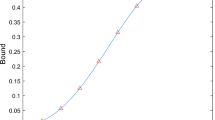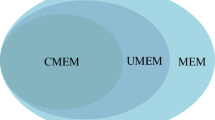Appendix
Here, we give our proofs of Theorems 2 and 4 and provide details of some calculations in the main text. Firstly, we list several properties of the Weyl operators that will be used:
$$\begin{aligned} {\left\{ \begin{array}{ll}D(\lambda _1)D(\lambda _2)=\mathrm{exp }\left( \frac{\lambda _1\lambda _2^*-\lambda _1^*\lambda _2}{2}\right) D(\lambda _1+\lambda _2);\\ \mathrm{Tr}(D(\lambda ))=\pi \delta ^{(2)}(\lambda );\\ D^\dag (\lambda )=D(-\lambda ).\end{array}\right. } \end{aligned}$$
(20)
Assume that \(\{G(\lambda )\}\) and \(\{\tilde{G}(\lambda )\}\) are any two CVLOOs for subsystems A and B, respectively.
By Lemma 1, we have
$$\begin{aligned} \begin{aligned}F_2=&\int \langle G(\lambda )\otimes I-I\otimes \tilde{G}(\lambda )\rangle _{\rho _{ AB }}^2\mathrm{d^2}\lambda \\ =&\int \left( \langle G(\lambda )\rangle _{\rho _A}-\langle \tilde{G}(\lambda )\rangle _{\rho _B}\right) ^2\mathrm{d^2}\lambda \\ =&\int \langle G(\lambda )\rangle _{\rho _A}^2\mathrm{d^2}\lambda -2\int \langle G(\lambda )\rangle _{\rho _A}\langle \tilde{G}(\lambda )\rangle _{\rho _B}\mathrm{d^2}\lambda +\int \langle \tilde{G}(\lambda )\rangle ^2_{\rho _B}\mathrm{d^2}\lambda \\ =&\mathrm{Tr}(\rho _A^2)+\mathrm{Tr}(\rho _B^2)-2\int \langle G(\lambda )\rangle _{\rho _A}\langle \tilde{G}(\lambda )\rangle _{\rho _B}\mathrm{d^2}\lambda .\end{aligned} \end{aligned}$$
So
$$\begin{aligned} \begin{aligned} F(\rho _{ AB })=\,\,&1-\frac{1}{2}\left( \mathrm{Tr}(\rho _A^2)+\mathrm{Tr}(\rho _B^2)\right) +\int \langle G(\lambda )\rangle _{\rho _A}\langle \tilde{G}(\lambda )\rangle _{\rho _B}\mathrm{d^2}\lambda \\&-\int \langle G(\lambda )\otimes \tilde{G}(\lambda )\rangle _{\rho _{ AB }}\mathrm{d^2}\lambda \\&-\frac{1}{2}\left( 2-\mathrm{Tr}(\rho _A^2)-\mathrm{Tr}(\rho _B^2)-2\sqrt{1-\mathrm{Tr}(\rho _A^2})\sqrt{1-\mathrm{Tr}(\rho _B^2})\right) \\ =&\int \langle G(\lambda )\rangle _{\rho _A}\langle \tilde{G}(\lambda )\rangle _{\rho _B}\mathrm{d^2}\lambda -\int \langle G(\lambda )\otimes \tilde{G}(\lambda )\rangle _{\rho _{ AB }}\mathrm{d^2}\lambda \\&+\sqrt{1-\mathrm{Tr}(\rho _A^2})\sqrt{1-\mathrm{Tr}(\rho _B^2}). \end{aligned} \end{aligned}$$
This implies that \(F(\rho _{ AB })\ge 0\) if and only if
$$\begin{aligned}&\left( 1-\mathrm{Tr}(\rho _A^2))(1-\mathrm{Tr}(\rho _B^2)\right) \nonumber \\&\quad \ge \left[ \int \langle G(\lambda )\otimes \tilde{G}(\lambda )\rangle _{\rho _{ AB }}\mathrm{d^2}\lambda -\int \langle G(\lambda )\rangle _{\rho _A}\langle \tilde{G}(\lambda )\rangle _{\rho _B}\mathrm{d^2}\lambda \right] ^2, \end{aligned}$$
(21)
that is, the inequalities in Theorems 2 and 4 are equivalent. In the following, we will give a proof of Theorem 4, and then, Theorem 2 follows.
Proof of Theorem 4
Since \(\rho _{ AB }\) is separable, it is the trace-norm limit of the states of the form
$$\begin{aligned} \rho _n=\sum _{i=1}^{k_n}p_{i,n}\rho _{i,n}^A\otimes \rho _{i,n}^B, \end{aligned}$$
where \(\rho _{i,n}^A\) and \(\rho _{i,n}^B\) are, respectively, states of subsystems A and B, \(\{p_{i,n}\}\) is a probability distribution. Then,
$$\begin{aligned} \rho _A=\lim _{n\rightarrow \infty }\sum _{i=1}^{k_n}p_{i,n}\rho _{i,n}^A=\lim _{n\rightarrow \infty }(\rho _n)_A\ \ \mathrm{and}\ \ \rho _B=\lim _{n\rightarrow \infty }\sum _{i=1}^{k_n}p_{i,n}\rho _{i,n}^B=\lim _{n\rightarrow \infty }(\rho _n)_B.\nonumber \\ \end{aligned}$$
(22)
We claim that Ineq. (21) holds for \(\rho _n\), that is,
$$\begin{aligned} \left( 1-\mathrm{Tr}((\rho _n)_A^2))(1-\mathrm{Tr}((\rho _n)_B^2)\right) \ge \left[ \int \left( \langle G(\lambda )\otimes \tilde{G}(\lambda )\rangle _{\rho _n}-\langle G(\lambda )\rangle _{(\rho _n)_A}\langle \tilde{G}(\lambda )\rangle _{(\rho _n)_B}\right) \mathrm{d^2}\lambda \right] ^2. \end{aligned}$$
(21′)
For sake of simplicity, we write \(\rho _n=\sum _{i=1}^mp_i\rho _i^A\otimes \rho _i^B\). Then,
$$\begin{aligned} \begin{aligned}&\langle G(\lambda )\otimes \tilde{G}(\lambda )\rangle _{\rho _n}-\langle G(\lambda )\rangle _{(\rho _n)_A}\langle \tilde{G}(\lambda )\rangle _{(\rho _n)_B}\\&\quad =\sum _{i=1}^mp_i\langle G(\lambda )\rangle _{\rho _i^A}\langle \tilde{G}(\lambda )\rangle _{\rho _i^B}-\sum _{i,j=1}^mp_ip_j\langle G(\lambda )\rangle _{\rho _i^A}\langle \tilde{G}(\lambda )\rangle _{\rho _j^B}\\&\quad = \sum _{i=1}^mp_i\langle G(\lambda )-\sum _{j=1}^mp_j\langle G(\lambda )\rangle _{\rho _j^A}\rangle _{\rho _i^A}\langle \tilde{G}(\lambda )-\sum _{j=1}^mp_j\langle \tilde{G}(\lambda )\rangle _{\rho _j^B}\rangle _{\rho _i^B}\\&\quad \le \left( \sum _{i=1}^mp_i\langle G(\lambda )-\sum _{j=1}^mp_j\langle G(\lambda )\rangle _{\rho _j^A}\rangle _{\rho _i^A}^2\right) ^{\frac{1}{2}}\\&\quad \times \left( \sum _{i=1}^mp_i\langle \tilde{G}(\lambda )-\sum _{j=1}^mp_j\langle \tilde{G}(\lambda )\rangle _{\rho _j^B}\rangle _{\rho _i^B}^2\right) ^{\frac{1}{2}}, \end{aligned} \end{aligned}$$
where the last inequality is due to Cauchy–Schwarz inequality. So
$$\begin{aligned}&\left[ \int \left( \langle G(\lambda )\otimes \tilde{G}(\lambda )\rangle _{\rho _n}-\langle G(\lambda )\rangle _{(\rho _n)_A}\langle \tilde{G}(\lambda )\rangle _{(\rho _n)_B}\right) \mathrm{d^2}\lambda \right] ^2\nonumber \\&\quad \le \left[ \int \left( \sum _{i=1}^mp_i\langle G(\lambda )-\sum _{j=1}^mp_j\langle G(\lambda )\rangle _{\rho _j^A}\rangle _{\rho _i^A}^2\right) ^{\frac{1}{2}}\right. \nonumber \\&\qquad \left. \cdot \,\left( \sum _{i=1}^mp_i\langle \tilde{G}(\lambda )-\sum _{j=1}^mp_j\langle \tilde{G}(\lambda )\rangle _{\rho _j^B}\rangle _{\rho _i^B}^2\right) ^{\frac{1}{2}}\mathrm{d^2}\lambda \right] ^2\\&\quad \le \left[ \int \sum _{i=1}^mp_i\langle G(\lambda )-\sum _{j=1}^mp_j\langle G(\lambda )\rangle _{\rho _j^A}\rangle _{\rho _i^A}^2\mathrm{d^2}\lambda \right] \nonumber \\&\qquad \cdot \,\left[ \int \sum _{i=1}^mp_i\langle \tilde{G}(\lambda )-\sum _{j=1}^mp_j\langle \tilde{G}(\lambda )\rangle _{\rho _j^B}\rangle _{\rho _i^B}^2\mathrm{d^2}\lambda \right] .\nonumber \end{aligned}$$
(23)
Thus, if we can prove that the inequalities
$$\begin{aligned} \int \sum _{i=1}^mp_i\langle G(\lambda )-\sum _{j=1}^mp_j\langle G(\lambda )\rangle _{\rho _j^A}\rangle _{\rho _i^A}^2\mathrm{d^2}\lambda \le 1-\mathrm{Tr}((\rho _n)_A^2) \end{aligned}$$
(24)
and
$$\begin{aligned} \int \sum _{i=1}^mp_i\langle \tilde{G}(\lambda )-\sum _{j=1}^mp_j\langle \tilde{G}(\lambda )\rangle _{\rho _j^B}\rangle _{\rho _i^B}^2\mathrm{d^2}\lambda \le 1-\mathrm{Tr}((\rho _n)_B^2) \end{aligned}$$
(25)
hold, then Ineqs. (23)–(25) imply that Ineq. (21\(^\prime \)) is true.
In fact, as \(\mathrm{Tr}(\sigma ^2)\le 1\) for any states \(\sigma \), by Lemma 1 we have
$$\begin{aligned}&\int \sum _{i=1}^mp_i\langle G(\lambda )-\sum _{j=1}^np_j\langle G(\lambda )\rangle _{\rho _j^A}\rangle _{\rho _i^A}^2\mathrm{d^2}\lambda \\&\quad =\int \sum _{i=1}^mp_i\langle G(\lambda )-\langle G(\lambda )\rangle _{(\rho _n)^A}\rangle _{\rho _i^A}^2\mathrm{d^2}\lambda \\&\quad =\int \sum _{i=1}^mp_i \left[ \langle G(\lambda )\rangle _{\rho _i^A}^2-2\langle G(\lambda )\rangle _{(\rho _n)^A}\langle G(\lambda )\rangle _{\rho _i^A}+\langle G(\lambda )\rangle _{(\rho _n)^A}^2\right] \mathrm{d^2}\lambda \\&\quad =\int \sum _{i=1}^mp_i \langle G(\lambda )\rangle _{\rho _i^A}^2\mathrm{d^2}\lambda +\int \sum _{i=1}^mp_i\langle G(\lambda )\rangle _{(\rho _n)^A}^2\mathrm{d^2}\lambda \\&\qquad -\,2\int \sum _{i=1}^mp_i\langle G(\lambda )\rangle _{(\rho _n)^A}\langle G(\lambda )\rangle _{\rho _i^A}\mathrm{d^2}\lambda \\&\quad =\int \sum _{i=1}^mp_i \langle G(\lambda )\rangle _{\rho _i^A}^2\mathrm{d^2}\lambda +\int \langle G(\lambda )\rangle _{(\rho _n)^A}^2\mathrm{d^2}\lambda \\&\qquad -\,2\int \langle G(\lambda )\rangle _{(\rho _n)^A}\sum _{i=1}^mp_i\langle G(\lambda )\rangle _{\rho _i^A}\mathrm{d^2}\lambda \\&\quad =\int \sum _{i=1}^mp_i \langle G(\lambda )\rangle _{\rho _i^A}^2\mathrm{d^2}\lambda -\int \langle G(\lambda )\rangle _{(\rho _n)^A}^2\mathrm{d^2}\lambda \\&\quad =\sum _{i=1}^mp_i\int \langle G(\lambda )\rangle _{\rho _i^A}^2\mathrm{d^2}\lambda -\mathrm{Tr}((\rho _n)_A^2)\\&\quad =\sum _{i=1}^mp_i\mathrm{Tr}((\rho _i)_A^2)-\mathrm{Tr}((\rho _n)_A^2)\le 1-\mathrm{Tr}((\rho _n)_A^2). \end{aligned}$$
That is, Ineq. (24) holds. Similarly, one can check that Ineq. (25) is also true. Hence, Ineq. (21\(^\prime \)) holds.
Now, combining Ineq. (21\(^\prime \)) and Eq. (22), one can easily check that Ineq. (21) holds, completing the proof of the theorem. \(\square \)
Recall that for any bipartite state \(\rho _{ AB }\), its characteristic function is \(\chi (\lambda _1,\lambda _2)=\mathrm{Tr}(\rho _{ AB } D_1(\lambda _1)\otimes D_2(\lambda _2))\) and its Wigner function is \(W(\alpha _1,\alpha _2)=\frac{1}{\pi ^4}\int \mathrm{exp}[\sum _{i=1}^2(\lambda _i^*\alpha _i-\lambda _i\alpha _i^*)] \chi (\lambda _1,\lambda _2)\mathrm{d^2}\lambda _1\mathrm{d^2}\lambda _2.\) So
$$\begin{aligned} \rho _{ AB }= & {} \frac{1}{\pi ^{2}}\int \mathrm{Tr}(\rho _{ AB }D_1(\lambda _1)\otimes D_2(\lambda _2))D_1(-\lambda _1)\otimes D_2(-\lambda _2)\mathrm{d^{2}}\lambda _1\mathrm{d^2}\lambda _2\nonumber \\= & {} \frac{1}{\pi ^{2}}\int W(\alpha _1,\alpha _2)\mathrm{exp}\left[ \sum _{i=1}^2(\lambda _i\alpha _i^*-\lambda _i^*\alpha _i)\right] D_1(-\lambda _1)\otimes D_2(-\lambda _2)\prod _{i=1}^2\mathrm{d^{2}}\lambda _i\mathrm{d^2}\alpha _i\nonumber \\= & {} \frac{1}{\pi ^{2}}\int W(\alpha _1,\alpha _2)\mathrm{exp}\left[ \sum _{i=1}^2(\lambda _i^*\alpha _i-\lambda _i\alpha _i^*)\right] D_1(\lambda _1)\otimes D_2(\lambda _2)\prod _{i=1}^2\mathrm{d^{2}}\lambda _i\mathrm{d^2}\alpha _i.\nonumber \\ \end{aligned}$$
(26)
Then,
$$\begin{aligned} {\left\{ \begin{array}{ll}\rho _A=\mathrm{Tr}_B(\rho _{ AB })=\frac{1}{\pi }\int W(\alpha _1,\alpha _2)\mathrm{exp}(\lambda _1^*\alpha _1-\lambda _1\alpha _1^*)D_1(\lambda _1)\mathrm{d^{2}}\lambda _1\mathrm{d^2}\alpha _1\mathrm{d^2}\alpha _2,\\ \rho _B=\mathrm{Tr}_A(\rho _{ AB })=\frac{1}{\pi }\int W(\alpha _1,\alpha _2)\mathrm{exp}(\lambda _2^*\alpha _2-\lambda _2\alpha _2^*)D_2(\lambda _2)\mathrm{d^{2}}\lambda _2\mathrm{d^2}\alpha _1\mathrm{d^2}\alpha _2.\end{array}\right. } \end{aligned}$$
(27)
It follows that
$$\begin{aligned} {\left\{ \begin{array}{ll} \mathrm{Tr}(\rho _A^2)=\pi \int W(\alpha _1,\alpha _2)W(\alpha _1,\beta _2)\mathrm{d^2}\alpha _1\mathrm{d^2}\alpha _2\mathrm{d^2}\beta _2; \\ \mathrm{Tr}(\rho _B^2)=\pi \int W(\alpha _1,\alpha _2)W(\beta _1,\alpha _2)\mathrm{d^2}\alpha _1\mathrm{d^2}\alpha _2\mathrm{d^2}\beta _1. \end{array}\right. } \end{aligned}$$
(28)
Here, we have used the relation Eq. (20) and the integral \(\int \mathrm{exp}(\lambda ^*z-\lambda z^*)\mathrm{d^2}\lambda =\pi ^2\delta ^{(2)}(z)\).
Now let
$$\begin{aligned} \{G(\lambda )\}=\{{\mathcal {G}}(\lambda )\}\ \ \mathrm{and}\ \ \{\tilde{G}(\lambda )\}=\left\{ \sqrt{|\mu _1^2-\mu _2^2|} {\mathcal {G}}(-\mu _1\lambda -\mu _2\lambda ^*)\right\} , \end{aligned}$$
where \(\mu _1\) and \(\mu _2\) are any two real numbers with \(\mu _1\not =\pm \mu _2\). Here, \(\{{\mathcal {G}}(\lambda )\}\) are defined as in Eq. (1). By Eq. (20), it is easy to check that
$$\begin{aligned}&\mathrm{Tr}({\mathcal {G}}(-\mu _1\lambda -\mu _2\lambda ^*){\mathcal {G}}(-\mu _1\lambda ^\prime -\mu _2\lambda ^{\prime *}))\\&\quad = \delta ^{(2)}(\mu _1(\lambda -\lambda ^\prime )+\mu _2(\lambda ^*-\lambda ^{\prime *}))\\&\quad = \frac{1}{|\mu _1^2-\mu _2^2|}\delta ^{(2)}(\lambda -\lambda ^\prime ), \end{aligned}$$
and so \(\{{\mathcal {G}}(\lambda )\}\) and \(\{\sqrt{|\mu _1^2-\mu _2^2|}{\mathcal {G}}(-\mu _1\lambda -\mu _2\lambda ^*)\}\) are two CVLOOs.
Now let us prove Eq. (9) in the main text by calculating \(F_2(\mu _1,\mu _2)=\int \langle G(\lambda )\otimes I-I\otimes \tilde{G}(\lambda )\rangle _{\rho _{ AB }}^2\mathrm{d^2}\lambda \). Since
$$\begin{aligned}&\rho _{ AB }(G(\lambda )\otimes I-I\otimes \tilde{G}(\lambda ))= \rho _{ AB }({\mathcal {G}}(\lambda )\otimes I\\&\qquad -\,\sqrt{|\mu _1^2-\mu _2^2|}I\otimes {{\mathcal {G}}}(-\mu _1\lambda -\mu _2\lambda ^*))\\&\quad =\rho _A{\mathcal {G}}(\lambda )-\sqrt{|\mu _1^2-\mu _2^2|}\rho _B{\mathcal {G}}(-\mu _1\lambda -\mu _2\lambda ^*), \end{aligned}$$
by Eq. (27), we have
$$\begin{aligned}&F_2(\mu _1,\mu _2) \\&\quad =\int _{{Re}\lambda >0}\left[ \mathrm{Tr}\left( \rho _A\frac{D(\lambda )+D^\dag (\lambda )}{\sqrt{2\pi }}\right) -\sqrt{|\mu _1^2-\mu _2^2|}\rho _B\mathrm{Tr}\right. \\&\qquad \left. \left( \rho _B\frac{D(-\mu _1\lambda -\mu \lambda ^*)+D^\dag (-\mu _1\lambda -\mu \lambda ^*)}{\sqrt{2\pi }}\right) \right] ^2\mathrm{d^2}\lambda \\&\qquad +\,\int _{{Re}\lambda <0}\left[ \mathrm{Tr}(\rho _A\frac{D(\lambda )-D^\dag (\lambda )}{i\sqrt{2\pi }}) -\sqrt{|\mu _1^2-\mu _2^2|}\rho _B\mathrm{Tr}\right. \\&\qquad \left. \left( \rho _B\frac{D(-\mu _1\lambda -\mu \lambda ^*)-D^\dag (-\mu _1\lambda -\mu \lambda ^*)}{i\sqrt{2\pi }}\right) \right] ^2\mathrm{d^2}\lambda \\&\quad =\frac{1}{2\pi }\int _{{Re}\lambda >0}\left[ \int W(\alpha _1,\alpha _2)e^{\lambda _1\wedge \alpha _1}(\delta ^{(2)}(\lambda _1+\lambda )+\delta ^{(2)}(\lambda _1-\lambda ))\mathrm{d^2}\lambda _1\mathrm{d^2}\alpha _1\mathrm{d^2}\alpha _2\right. \\&\qquad -\,\sqrt{|\mu _1^2-\mu _2^2|}\cdot \int W(\alpha _1,\alpha _2)e^{\lambda _2\wedge \alpha _2} (\delta ^{(2)}(\lambda _2-\mu _1\lambda -\mu _2\lambda ^*)\\&\qquad \left. +\,\delta ^{(2)}(\lambda _2+\mu _1\lambda +\mu _2\lambda ^*))\mathrm{d^2}\lambda _2\mathrm{d^2}\alpha _1\mathrm{d^2}\alpha _2\right] ^2\mathrm{d^2}\lambda \\&\qquad -\,\frac{1}{2\pi }\int _{{Re}\lambda <0}\left[ \int W(\alpha _1,\alpha _2)e^{\lambda _1\wedge \alpha _1}(\delta ^{(2)}(\lambda _1+\lambda )-\delta ^{(2)}(\lambda _1-\lambda ))\mathrm{d^2}\lambda _1\mathrm{d^2}\alpha _1\mathrm{d^2}\alpha _2\right. \\&\qquad -\,\sqrt{|\mu _1^2-\mu _2^2|}\cdot \int W(\alpha _1,\alpha _2)e^{\lambda _2\wedge \alpha _2} (\delta ^{(2)}(\lambda _2-\mu _1\lambda -\mu _2\lambda ^*)\\&\qquad \left. -\,\delta ^{(2)}(\lambda _2+\mu _1\lambda +\mu _2\lambda ^*))\mathrm{d^2}\lambda _2\mathrm{d^2}\alpha _1\mathrm{d^2}\alpha _2\right] ^2\mathrm{d^2}\lambda , \end{aligned}$$
as desired, where \(e^{\lambda \wedge \alpha }=e^{\lambda ^*\alpha -\lambda \alpha ^*}\).
Assume that \(\rho _{ AB }\) is any two-mode Gaussian state. The Wigner function of \(\rho _{ AB }\) is
$$\begin{aligned} W(\alpha _1,\alpha _2)=\frac{1}{4\pi ^2\sqrt{\mathrm{Det}{\mathcal {V}}}}\mathrm{exp}\left( \frac{-\xi {\mathcal {V}}^{-1}\xi ^{\mathrm{T}}}{2}\right) , \end{aligned}$$
(29)
where \(\mathcal {V}\) is the standard covariance matrix given by Eq. (15) in the main text, \(\xi =(x_1,p_1,x_2,p_2)\) is the four-dimensional real vector and \(\alpha _i=x_i+ip_i\).
It is easy to calculate \(\mathrm{Det}{\mathcal {V}}=(ab-c_1^2)(ab-c_2^2)\) and
$$\begin{aligned} \xi {\mathcal {V}}^{-1}\xi ^{\mathrm{T}}= & {} \frac{1}{\mathrm{Det}{\mathcal {V}}}\left[ \left( ab-c_2^2\right) \left( bx_1^2-2c_1x_1x_2+ax_2^2\right) \right. \\&\left. +\,\left( ab-c_1^2\right) \left( bp_1^2-2c_2p_1p_2+ap_2^2\right) \right] . \end{aligned}$$
Substituting this Gaussian state Wigner function (29) into (28) and using the following Gaussian functional integral formula six times:
$$\begin{aligned} \int _{-\infty }^{+\infty }\mathrm{exp}(-ax^2+bx+c)\mathrm{d}x=\sqrt{\frac{\pi }{a}}\mathrm{exp}\left( \frac{b^2}{4a}+c\right) ,\ \ a>0, \end{aligned}$$
one can get
$$\begin{aligned} \mathrm{Tr}\left( \rho _A^2\right) =\frac{1}{4a}\ \ \mathrm{and}\ \ \mathrm{Tr}(\rho _B^2)=\frac{1}{4b}. \end{aligned}$$
Finally, let us prove Eq. (16). For \(F_2(\mu _1,\mu _2)\), one can obtain
$$\begin{aligned}&\int W(\alpha _1,\alpha _2)e^{\lambda _1\wedge \alpha _1}(\delta ^{(2)}(\lambda _1+\lambda )\pm \delta ^{(2)}(\lambda _1-\lambda ))\mathrm{d^2}\lambda _1\mathrm{d^2}\alpha _1\mathrm{d^2}\alpha _2\\&\quad =\int e^{-2a|\lambda _1|^2}(\delta ^{(2)}(\lambda _1+\lambda )\pm \delta ^{(2)}(\lambda _1-\lambda ))\mathrm{d^2}\lambda _1 \end{aligned}$$
and
$$\begin{aligned}&\int W(\alpha _1,\alpha _2)e^{\lambda _2\wedge \alpha _2} \left( \delta ^{(2)}(\lambda _2-\mu _1\lambda -\mu _2\lambda ^*)\!\pm \!\delta ^{(2)}(\lambda _2+\mu _1\lambda +\mu _2\lambda ^*)\right) \mathrm{d^2}\lambda _2\mathrm{d^2}\alpha _1\mathrm{d^2}\alpha _2\\&\quad =\int e^{-2b|\lambda _2|^2}(\delta ^{(2)}(\lambda _1-\mu _1\lambda -\mu _2\lambda ^*)\pm \delta ^{(2)}(\lambda _1+\mu _1\lambda +\mu _2\lambda ^*))\mathrm{d^2}\lambda _2. \end{aligned}$$
So
$$\begin{aligned}&2\pi F_2(\mu _1,\mu _2)\\&\quad =\int _{{Re}\lambda >0}\left[ \int e^{-2a|\lambda _1|^2}\left( \delta ^{(2)}(\lambda _1+\lambda )+\delta ^{(2)}(\lambda _1-\lambda )\right) \mathrm{d^2}\lambda _1\right. \\&\qquad \left. -\,\sqrt{|\mu _1^2-\mu _2^2|} e^{-2b|\lambda _2|^2}\left( \delta ^{(2)}(\lambda _1-\mu _1\lambda -\mu _2\lambda ^*)+\delta ^{(2)}(\lambda _1+\mu _1\lambda +\mu _2\lambda ^*)\right) \mathrm{d^2}\lambda _2\right] ^2\mathrm{d^2}\lambda \\&\qquad -\,\int _{{Re}\lambda <0}\left[ \int e^{-2a|\lambda _1|^2}\left( \delta ^{(2)}(\lambda _1+\lambda )-\delta ^{(2)}(\lambda _1-\lambda )\right) \mathrm{d^2}\lambda _1\right. \\&\qquad \left. -\,\sqrt{|\mu _1^2-\mu _2^2|} e^{-2b|\lambda _2|^2}\left( \delta ^{(2)}(\lambda _1-\mu _1\lambda -\mu _2\lambda ^*)-\delta ^{(2)}(\lambda _1+\mu _1\lambda +\mu _2\lambda ^*)\right) \mathrm{d^2}\lambda _2\right] ^2\mathrm{d^2}\lambda \\&\quad =\int _{{Re}\lambda >0}\left[ 2e^{-2a|\lambda |^2}-2\sqrt{|\mu _1^2-\mu _2^2|}e^{-2b|\mu _1\lambda +\mu _2\lambda ^*|^2}\right] ^2\mathrm{d^2}\lambda \\&\quad =2\pi \left[ \frac{1}{4a}+\frac{1}{4b}-\sqrt{\frac{|\mu _1^2-\mu _2^2|}{(a+b(\mu _1+\mu _2)^2)(a+b(\mu _1-\mu _2)^2)}}\right] , \end{aligned}$$
that is,
$$\begin{aligned} F_2(\mu _1,\mu _2)=\frac{1}{4a}+\frac{1}{4b}-\sqrt{\frac{|\mu _1^2-\mu _2^2|}{(a+b(\mu _1+\mu _2)^2)(a+b(\mu _1-\mu _2)^2)}}. \end{aligned}$$




